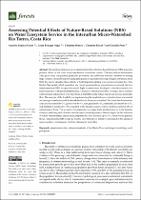| dc.description.abstract | The implementation of green infrastructure (GI) as Nature-Based Solutions (NBS) generates positive effects on the water ecosystem service in an urban context. Practices such as bioretention cells, green roofs, rain gardens, permeable pavements, and infiltration trenches contribute to treating large volumes of runoff and providing safe spaces for populations living in highly urbanized areas. With the aim to simulate these effects, a hydrological modeling was carried out using the i-Tree Hydro Plus model, which quantified the runoff generated from precipitation events and effective transformations (NBS) to cope with runoff. Eight scenarios were developed: a baseline scenario, five future scenarios with green infrastructure, a scenario with increased tree coverage, and a scenario with increased urbanization. Our hypothesis is that NBS would reduce runoff and increase permeable flow. The analysis of the feasibility of implementing the modeled green infrastructures was carried out through consultation with local stakeholders in the micro-watershed. We found that bioretention cells decrease runoff by 5%, green roofs by 4%, rain gardens by 4%, permeable pavements by 4.5%, and infiltration trenches by 7.5% compared to the baseline scenario where runoff accounts for 32% of water balance flows. The scenario of increased tree coverage had a similar behavior to the baseline scenario, indicating that efforts in this alternative would generate a limited impact on the reduction of runoff. With increased urbanization, impermeable flow increases up to 78%, which would generate floods. Implementing NBS would be feasible since this type of initiative is included in the agenda of many regulatory instruments of urban planning in Costa Rica. | es_ES |


